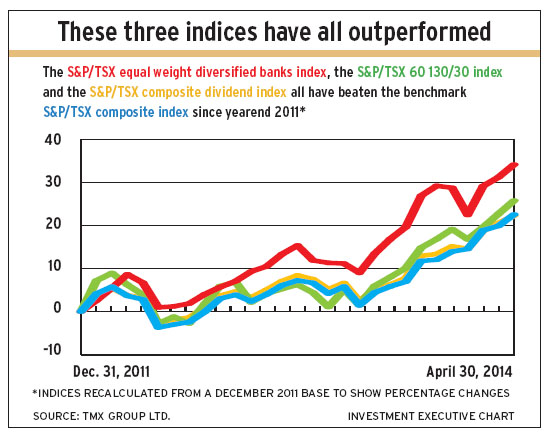
As someone who oversees investments for clients, you want your recommendations to beat “the market,” which in Canada is the S&P/TSX composite index. To help do this, you should consider the many new stock indices that track different parts of the market or that provide benchmarks to measure the effectiveness of specific investment strategies.
Most of the new indices have been designed to be the bases for exchange-traded funds (ETFs) – although many are not tracked by a clone ETF.
TSX Inc., a subsidiary of Toronto-based TMX Group Ltd., and S&P Dow Jones Indices LLC have been busy creating new indices, launching two new ones in 2013, three in 2012, five in 2011 and five in 2010. (This excludes preferred-share indices and variations on existing or new indices.)
Beating the S&P/TSX composite index over the past couple of years was possible if you used any of three new indices. That’s because since yearend 2011, the S&P/TSX equal weight diversified banks index, the S&P/TSX 60 130/30 index and the S&P/TSX composite dividend index posted greater gains than the composite.
Admittedly, two years or so of market performance is either short or intermediate term. Still, the results do show that “the market” can be beaten.
Case in point: the S&P/TSX equal weight diversified banks index rose by 32.7% vs the S&P/TSX composite index’s 21.6% rise in the period from yearend 2011 to April 30, 2014.
The gain is even more impressive when the total-return versions of the indices (TRIV, in the TSX’s way of describing things) are used. By this measure, the banks index rose by 46.3% vs 30.4% for the composite index.
Mind you, the S&P/TSX TRIV indices should be viewed with caution: first, they ignore taxes on dividends reinvested; second, dividends are reinvested the day on which they are paid, which is difficult to do in real life.
The banks index is dead simple compared with others, being straightforward to replicate. So, for example, if you have $100,000 to invest in banks, you allocate one-sixth (or $16,700) to each of the six major Canadian banks. (In fact, there’s already an ETF out there that does that for you: BMO S&P/TSX Equal Weight Banks Index ETF, sponsored by BMO Asset Management Inc. of Toronto.)
The next best-performing index, the S&P/TSX 60 130/30 index, has no corresponding ETF. It has risen by 24.2% since yearend 2011, or by 34.2% on a dividend-reinvested total-return basis.
This index is a complex indexing product. Basically, it overweights 10 of the composite index’s largest 60 stocks, and underweights 10. “Quantamental” calculations do this, taking into account standard measurements, such as profitability, but also analysts’ estimates.
Of the 10 stocks currently overweighted, the top three are banks: Toronto-Dominion Bank, Royal Bank of Canada and Bank of Nova Scotia. In descending order, the remaining overweighted stocks are Enbridge Inc., Manulife Financial Corp., Telus Corp., Suncor Energy Inc., Crescent Point Energy Corp., Agrium Inc. and Canadian National Railway Co.
The most underweighted stock in the S&P/TSX 60 130/30 index is Saputo Inc., followed in order by Tim Hortons Inc., Imperial Oil Ltd., Agnico Eagle Miles Ltd., EnCana Corp., BlackBerry Ltd., Talisman Energy Inc., Kinross Gold Corp., Magna International Inc. and Barrick Gold Corp.
The third index to beat the S&P/TSX composite index is the S&P/TSX composite dividend index. This index is a subset of the composite index, consisting of stocks that pay regular dividends. It’s calculated in the same manner as the composite, on a capitalization-weighted basis.
Currently, the S&P/TSX composite dividend index contains 189 stocks. However, there is no ETF that clones this index. From yearend 2011 to April 30, this index rose by 22%, or 31.7% on a total-return basis.
Within a shorter time frame – the 16 months from yearend 2012 to April 30 – five S&P/TSX indices beat the S&P/TSX composite, which rose by 16.9% in this time span. Topping these outperformers is the S&P/TSX equal weight industrials index, which rose by 38.9%. This index began in 2012.
Trailing the industrial index is the S&P/TSX equal weight oil & gas index, which rose by 22.5%. This index also was introduced in 2012.
For the same period, the S&P/TSX equal weight diversified banks index rose by 20.1%, the S&P/TSX 60 130/30 index rose by 19.3% and the S&P/TSX completion index – a measure of mid-cap stocks – rose by 18.8%.
© 2014 Investment Executive. All rights reserved.